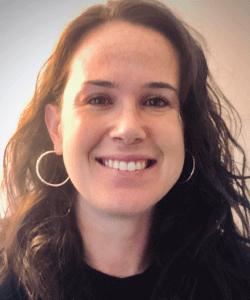
Back Page: Environment and Disinhibition
Arielle Baskin-Sommers is an associate professor of psychology and psychiatry at Yale University and a recipient of the APS 2021 Janet Taylor Spence Award. Her research explores the cognitive-affective processes associated with disinhibition, or a lack of restraint, and how it manifests in behaviors including impulsivity and a disregard for social norms.

What environmental factors can contribute to antisocial behavior and other forms of disinhibition?
Currently, my lab is focusing on two main environmental factors: community disadvantage and exposure to community violence. Since the early 2000s, the number of disadvantaged neighborhoods in the United States has been growing steadily and significantly. The features of concentrated disadvantage extend beyond economic poverty and include social, political, cultural, and spatial dynamics. These dynamics appear to have wide-ranging consequences for both communities and individuals, access to resources and collective collaboration. As a result, our lab has been looking at how concentrated disadvantage affects impacting cognitive and neural processes related to both resource decision-making and decision-making around social interactions.
Additionally, our lab is concerned with the effects of exposure to community violence on the development of antisocial behavior and mental health symptomatology. While 30% of youth nationwide report exposure to community violence, the rates for those in poor, urban communities range from 80% to 100%. Importantly, we find that exposure to community violence, as compared to other forms of trauma, produces distinct effects on cognition and emotion. We examine the impacts of community violence exposure on learning and trust—cognitive mechanisms that appear to be associated with justice system contact and poor outcomes across a wide range of domains.
What are some of the interventions you’re working on?
One is a communication training aimed at corrections officers. We chose the correctional setting for three reasons: Levels of exposure to violence and community disadvantage are significantly elevated among incarcerated individuals; the prison environment itself continues such exposure; and interactions with corrections officers are often filled with procedural injustices that fuel an already high level of distrust among incarcerated people. What is novel about this intervention is that it utilizes information about how incarcerated individuals respond to environmental cues and then trains officers to communicate in ways that acknowledge the effects of these mechanisms so as to engage in more productive interactions.
Components of this training include teaching officers how to (1) convey trustworthiness, fairness, and respect and (2) provide incarcerated individuals with opportunities to express, safely, their concerns. Our aims are to increase the well-being of both officers and incarcerated individuals by promoting procedural justice and, hopefully, changing the correctional environment so as not to reproduce the adverse environmental factors found in the community.
What common misconceptions do you hope to overturn with your research?
It is commonly thought that changing the environment alone will result in more prosocial behavior. While that might work for many individuals, it tends not to be sufficient for those most involved in antisocial conduct. Instead, for these individuals, there must also be changes in their cognitive and affective responses to the environment. Therefore, interventions need to address both the person and the environment in ways that are scientifically informed.
Additionally, much research and intervention work assumes that the effects of exposure to community violence are similar to those of other forms of trauma. Instead, our lab has been finding that community violence exposure has features and effects that are distinct and therefore distinguishable from other forms of trauma.
Cognitive-affective responses to concentrated disadvantage and exposure to violence are often framed as maladaptive. However, our lab has demonstrated that some responses may actually be adaptive in communities of disadvantage because they offer protection from predation and from criminal justice contacts.
In some of your recent work, you explore the use of big data to better understand and craft policies to improve brain and behavioral development. How can big data be leveraged responsibly, given the heterogeneity of experiences in which development occurs?
Big data allows researchers to have access to large enough samples to identify subgroups of individuals based on heterogeneity of experience. Big data also allows for the detection of trends across many individuals that can be used to create policy. For instance, we know that isolation has severe and adverse neurological, psychological, and physical effects across individuals, and this information can be used to advocate for policy changes around the use of solitary confinement. Similarly, exposure to toxins produces significant deleterious effects on development yet proliferates in both neighborhoods of concentrated disadvantage and correctional facilities. Research that uses big data can tell us a lot about the average group response, less so about a particular individual’s response, and therefore is suitable for informing policy that serves groups of individuals.